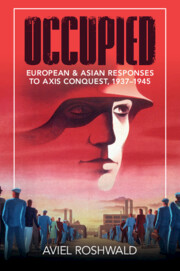Refine search
Actions for selected content:
15401 results in Military history
8 - The Ghosts of Colonialisms Past and the Weight of Occupations Present
- from Part III - Conquest in the Guise of Liberation (the Philippines, Indonesia, and Ukraine)
-
- Book:
- Occupied
- Published online:
- 20 April 2023
- Print publication:
- 27 April 2023, pp 309-388
-
- Chapter
- Export citation
6 - From Parochial Interests to Internationalist Visions: The Fractal Structures of Political Identity in Civil Wars
- from Part II - Fractured Societies and Fractal Identities: Civil Wars under Occupation (Greece, Yugoslavia, Italy, and China)
-
- Book:
- Occupied
- Published online:
- 20 April 2023
- Print publication:
- 27 April 2023, pp 198-242
-
- Chapter
- Export citation
Maps
-
- Book:
- Occupied
- Published online:
- 20 April 2023
- Print publication:
- 27 April 2023, pp x-x
-
- Chapter
- Export citation
Introduction
-
- Book:
- Occupied
- Published online:
- 20 April 2023
- Print publication:
- 27 April 2023, pp 1-12
-
- Chapter
- Export citation
Conclusion to Part III
- from Part III - Conquest in the Guise of Liberation (the Philippines, Indonesia, and Ukraine)
-
- Book:
- Occupied
- Published online:
- 20 April 2023
- Print publication:
- 27 April 2023, pp 389-396
-
- Chapter
- Export citation
5 - Continuities and Ruptures
- from Part II - Fractured Societies and Fractal Identities: Civil Wars under Occupation (Greece, Yugoslavia, Italy, and China)
-
- Book:
- Occupied
- Published online:
- 20 April 2023
- Print publication:
- 27 April 2023, pp 179-197
-
- Chapter
- Export citation
7 - Colonial Histories
- from Part III - Conquest in the Guise of Liberation (the Philippines, Indonesia, and Ukraine)
-
- Book:
- Occupied
- Published online:
- 20 April 2023
- Print publication:
- 27 April 2023, pp 257-308
-
- Chapter
- Export citation
Bibliography
-
- Book:
- Occupied
- Published online:
- 20 April 2023
- Print publication:
- 27 April 2023, pp 411-441
-
- Chapter
- Export citation
Part II - Fractured Societies and Fractal Identities: Civil Wars under Occupation (Greece, Yugoslavia, Italy, and China)
-
- Book:
- Occupied
- Published online:
- 20 April 2023
- Print publication:
- 27 April 2023, pp 133-250
-
- Chapter
- Export citation
Prologue to Part II
- from Part II - Fractured Societies and Fractal Identities: Civil Wars under Occupation (Greece, Yugoslavia, Italy, and China)
-
- Book:
- Occupied
- Published online:
- 20 April 2023
- Print publication:
- 27 April 2023, pp 135-141
-
- Chapter
- Export citation
Copyright page
-
- Book:
- Occupied
- Published online:
- 20 April 2023
- Print publication:
- 27 April 2023, pp iv-iv
-
- Chapter
- Export citation
Acknowledgments
-
- Book:
- Occupied
- Published online:
- 20 April 2023
- Print publication:
- 27 April 2023, pp xi-xiv
-
- Chapter
- Export citation
3 - The Shifting Parameters of the Patriotically Plausible
- from Part I - Patriotisms under Occupation (the Netherlands, France, Denmark, and Thailand)
-
- Book:
- Occupied
- Published online:
- 20 April 2023
- Print publication:
- 27 April 2023, pp 99-126
-
- Chapter
- Export citation
Index
-
- Book:
- Occupied
- Published online:
- 20 April 2023
- Print publication:
- 27 April 2023, pp 442-452
-
- Chapter
- Export citation
Conclusion to Part I
- from Part I - Patriotisms under Occupation (the Netherlands, France, Denmark, and Thailand)
-
- Book:
- Occupied
- Published online:
- 20 April 2023
- Print publication:
- 27 April 2023, pp 127-132
-
- Chapter
- Export citation
Dedication
-
- Book:
- Occupied
- Published online:
- 20 April 2023
- Print publication:
- 27 April 2023, pp v-vi
-
- Chapter
- Export citation
Part III - Conquest in the Guise of Liberation (the Philippines, Indonesia, and Ukraine)
-
- Book:
- Occupied
- Published online:
- 20 April 2023
- Print publication:
- 27 April 2023, pp 251-410
-
- Chapter
- Export citation

Occupied
- European and Asian Responses to Axis Conquest, 1937–1945
-
- Published online:
- 20 April 2023
- Print publication:
- 27 April 2023
4 - Personality
-
- Book:
- Holding Out
- Published online:
- 31 March 2023
- Print publication:
- 20 April 2023, pp 117-155
-
- Chapter
- Export citation
5 - Intelligence
-
- Book:
- Holding Out
- Published online:
- 31 March 2023
- Print publication:
- 20 April 2023, pp 156-189
-
- Chapter
- Export citation
